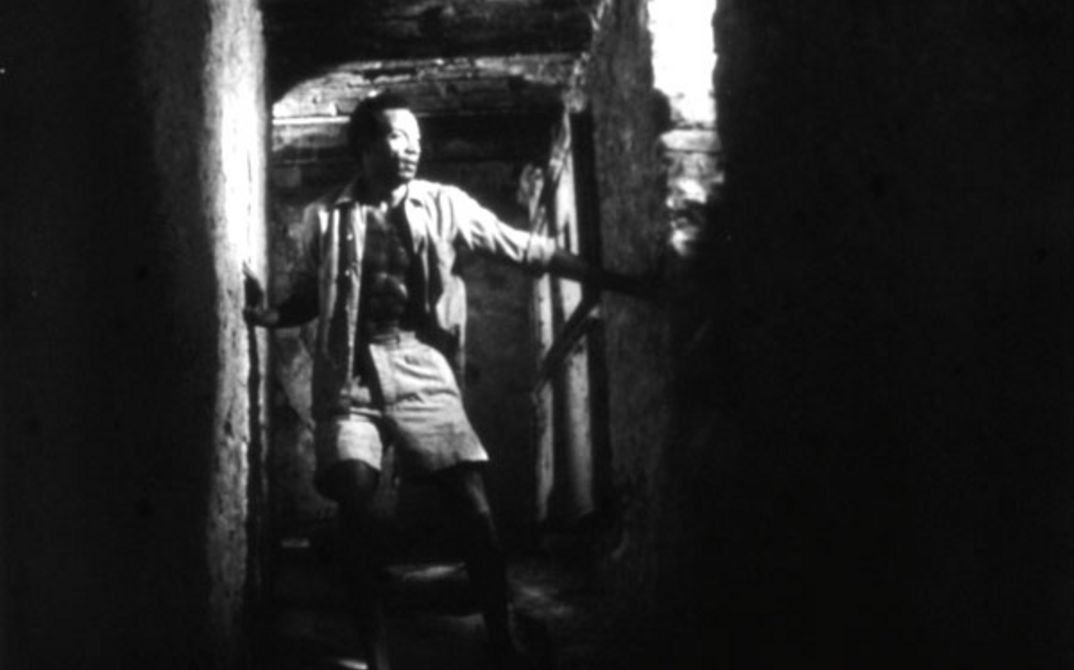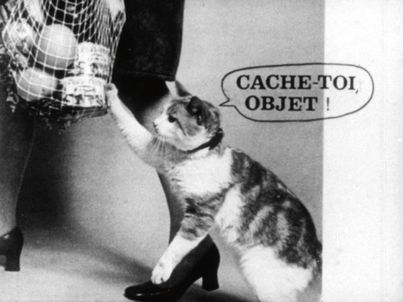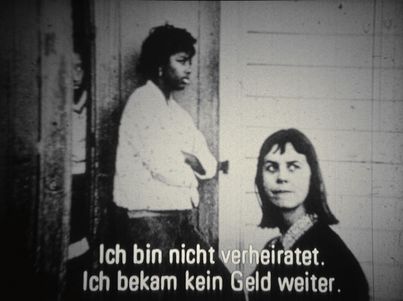
Monangambeee!
When Films Congregate
by Stefanie Schulte Strathaus
by Stefanie Schulte Strathaus
Monangambeee! is an exclamation that was used by activists in the anticolonial liberation struggle in Angola to call village assemblies. Monangambeee is also a short film by Sarah Maldoror about Portuguese ignorance in the face of Angolan culture and the humiliation imposed by the colonial powers, as well as a film about solidarity and resistance. The story is based on a novella by José Luandino Vieira about a political prisoner who asks his wife for a “complet”, which is an Angolan dish, and is subsequently suspected of demanding a “complet”, in this case, a suit, even though he’s still incarcerated.
In the film sheet published for the 1st International Forum of New Cinema, it says that, “one thing that’s unique about this short film is the fact that it was produced by the C.O.N.C.P.(Conference of Nationalist Organizations of the Portuguese Colonies). For the first time a political organization appears as a film producer: The idea is that the film to be handled commercially by the Slon cooperative, that is, sold to television and arthouse cinemas around the world.”
After its premiere at the 1st Forum in 1971, a print thus remained in the Arsenal collection, although Arsenal was still called Friends of the German Film Archive at the time. Despite some blurriness on the right-hand side of the image due to a production error, it was distributed in German-speaking countries. When the film was digitised in 2017, this print served as the source material, since no other material is available as of now.
Monangambeee also received its share of critique at the time. It was considered a women’s film, since it was too poetic to be a political film. Another film aggressively placed this accusation in its very title. The Woman’s Film by Louise Alaimo, Judy Smith, and Ellen Sorrin (USA 1970) is a portrait of American female workers and housewives produced by the San Francisco Newsreel collective: a film about dual burdens and oppression, about the structural connections between racism, sexism and class discrimination, as well as the energy of the collective.
The Woman’s Film is one of the films to be subtitled in German by the Forum, a convention which started from its very first year. The subtitled prints created to this end remained at Arsenal so that they could continue to be screened and distributed after the festival. The already remarkable sustainability of this practice came to have an even greater degree of foresight decades later, as numerous films from all over the world only survived because of it. These prints, which today are the only ones in existence, give Arsenal new duties, which I will come back to below.
The films by the Newsreel collective, which was founded in New York in 1967 and was dedicated to producing and distributing politically engaged films, are still being maintained and distributed to this day. This meant it was possible to have a new 16mm print of The Woman’s Film made for the anniversary program, since the only subtitled print contained a problem. The joint poster design for this year’s Forum and Forum Expanded shows a scene from the film of a white woman speaking, including the accompanying subtitle: “Ich trat in Streik!” [“I went on strike!”]. At this point in the film though, she is speaking about the fact that people only get heard as a group, and not as individuals. The actual moment where the sentence is uttered appears shortly afterwards. It’s a black woman who says it, although her words are “We went on strike!” The I and the We are thus newly interwoven (in the film Eine Prämie für Irene (A Bonus for Irene) by Helke Sander, which was screened in the same programme, we hear in a protest song: “Irene is the many”). At the first year of the Forum, with resources still limited and experience in subtitling techniques lacking, translation mistakes were sometimes inscribed into the prints, creating new levels of meaning that in this case were shifted yet further by the asynchronicity of the subtitles.
The title of a film by Chris Marker is fitting here too: Les mots ont un sens (which translates as “words have a meaning”), which also formed part of the 1971 programme and is now being shown in a newly restored version. The film portrays bookseller and publisher François Maspero, who published books during the 1960s and ‘70s on political topics, especially on the anti-colonial liberation struggles in Africa. The film was produced by the ISKRA collective, which developed out of Slon, the collective that had been launched by Chris Marker and which had also produced Monangambeee. The importance of the international circulation of films is evident in the creation of different language versions. A German dubbed version remained in distribution and thus also in the Arsenal archive.
The print lay on the shelf for decades, right next to Mes voisins (My Neighbours), a medium-length film by director Med Hondo, who died in 2019, that is partly contained within his over three-hour film Les bicots-nègres, vos voisins. The short film was not just shown in the programme of the first Forum, but also remained in the archive as a personal gift from the filmmaker to Ulrich Gregor. Med Hondo saw the orbit of the institution, whose cinema was also called “Arsenal”, as a place where political resistance could live on in the form of a so-called “other cinema.” For the print of Mes voisins, this also amounted to its very survival, enabling it to be restored.
Does “counter cinema” transform an archive where such films congregate into a “counter archive”?
Experimental films like Mare’s Tail by David Larcher as well as more than 30 other films shown at the first edition of the Forum also stayed at Arsenal (mare’s tail is a highly adaptable plant that can grow both underwater and on land, as well as everywhere between). Other avant-garde films were added to the collection too, as well as ones from countries seeking protection from censorship, from other private collections such as the Vollmann Private Collection or from the holdings of the Soviet Army, which entered the archive after the fall of the Wall. An archive put together in such a way cannot be subject to standard organisational criteria per se; it is not a national archive, it does not represent any genre, nor any historical period. It resists every attempt to interpret it. It is an archive that takes a stand. An archive of resistance.
The term cultural heritage has become a guiding concept in culture and politics. In the film sector, this category performs a key function in the distribution of resources for archiving, preservation and presentation. The focus here is on a strict definition of the concept that grasps cultural heritage as national heritage, and that relates the politics of film culture to the framework of the nation state. “Heritage,” according to film scholar Vinzenz Hediger in a text about the Arsenal’s archive work, “has therefore established itself as one of the leading categories for film culture, which has far-reaching consequences for the perception, classification and impact of artistic works, but also ephemeral film genres and archival materials.”
Due to its transnationality, the Arsenal collection resists being classified as one particular strand of a national cultural heritage. But that makes it all the more suited to function as a laboratory for examining and critically reflecting upon the category of film heritage and how we deal with it. Terms like “national focus,” “world cinema,” or “film nation” have played a large role in the history of the Forum, which is reflected in the archive. They also raise questions: as a Western, publically funded institution, what responsibility has Arsenal taken on over the years through such a programming direction? Who invented these terms and what tasks do they create for us in the present? Unlike the underpinnings of national cultural heritage, a digitisation can be motivated by a desire to bring a film back to its country of origin, such as for films which have only survived due to the existence of German-subtitled prints at Arsenal. In such cases, the institution that undertakes the digitisation cannot claim the rights to it. Archival work is far more than just dealing with the material. Archival work is a political practice.
For a long time already, it has no longer just been film historians who track down archives, but also scholars from other fields, as well as independent curators, filmmakers and artists, with all of them attempting via their individual projects to bring to light what was long buried there. Networks and platforms are formed. Universities launch new degree programs, like recently in Nigeria, where the University of Jos and the Nigerian Film Corporation in collaboration with the Masters programme “Film Culture: Archiving, Programming, Presentation” at the Goethe University in Frankfurt, the DFF – Deutsches Filminstitut & Filmmuseum, Arsenal and the Lagos Film Society are now offering a practice-oriented masters degree in Archiving.
In Indonesia, Uruguay, Egypt, Sudan, Guinea-Bissau, Nigeria and Angola, film prints and whole collections have been tracked down, often by young filmmakers and cinema owners to boot, who seek out lost material or come across it when setting up new cinema spaces and film labs or reactivating old ones. This brings numerous interconnections to light, even if we just look at the projects that Arsenal has been involved in. Who knew, for example, that Egyptian documentary filmmaker Atteyat Al Abnoudy worked with the same camerawoman as Helke Sander did on Die allseitig reduzierte Persönlichkeit – Redupers (The All-Round Reduced Personality – Redupers)? What did an Egyptian archivist write in his report when he was sent to East Berlin in 1966 to learn how to run a film archive? Are the print errors in Monangambeee due to the fact that the print had to be rushed out of the country?
Monangambeee! An exclamation to call assemblies. The films have already congregated. What’s needed now is for others to join in with their questions, knowledge and research interests. They don’t take away, they add. The archive’s users turn it into a place of production.
Counter archives set the archival landscape in motion. They call for counterproposals, for new, contemporary constellations. Like the films that they house, they develop a new language, new knowledge and new cultural, social and political spaces and possibilities for action – which we urgently need right now.

